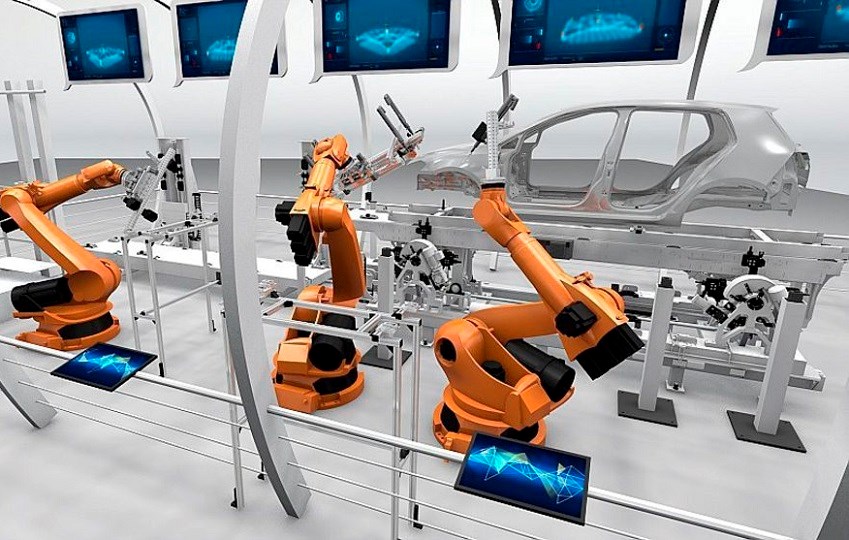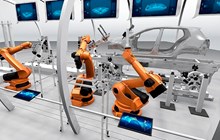We are now in the midst of the fourth industrial revolution. It is based on the use of cyber-physical systems where the growth of connected devices through the Internet of Things (IoT) will see digital transformation increase industrial plant performance. In addition, applications and digital services will also help build new digital business models that will differentiate organisations in the market.
At the heart of this ‘revolution’ sits data. Estimates predict that the total volume of data generated globally by 2020 will exceed 45 Zettabyte – up from 7.4 Zettabytes in 2015. This will, in part, be as a result of the growth in machine to machine connectivity through sensors, meters, devices and industrial machines.
Seamless and intelligent digital technology platforms, including virtual and augmented reality, digital twins & simulation, cloud technology and cyber-security protection, are set to have a profound impact on our industrial landscape over the coming decade.
IoT-driven benefits to industrial production are clear as it allows data to become actionable and deliver value to the business. In order to benefit, businesses have to embrace the technological forces that are transforming both society and now industry that will see the most successful evolve into data-driven digital enterprises.
Key capabilities for industrial users will follow.
By integrating new and existing assets and sensors to systems, the ability to aggregate data in real time becomes possible. From this position, it is possible to transform performance by building data profiling, undertaking trend analysis and creating predictive modelling capabilities with the help of visualisation processes that incorporate dataflow, data analysers and dashboards. This leads to insight and actions based on the ability to highlight trends and production anomalies and drive practical action plans across the plant such as predictive maintenance, health monitoring and status and KPI delivery.
Simulation will be key
A cycle of continuous improvement to product and production can be enhanced thanks to digital twinning – a process that links the virtual and real production worlds through the simulation of machines and plants. The ability, for example, to respond flexibly to individual customer requirements with small batch sizes calls for the use of simulation solutions along the entire value chain.
This is where the digital twin comes into its own, precisely duplicating and simulating the properties and performance features of a physical product, a product line, a process or a complete plant in the virtual world. A central data platform and high-performance network components are the basis of a digital twin that can be used to map and optimise an entire plant lifecycle. The common data platform enables all of the disciplines involved in a project to generate a common data model. This permits most of the processes usually carried out in sequence to be executed in parallel, thereby saving valuable time and expense.
Likewise, for plant availability objectives, the digital twin can drive tangible benefit. In order to increase the availability and reliability of a plant, the mechanical assets must be monitored since they are often the prime cause of unplanned downtime. Simple communication between control systems and the maintenance tool, plus access to all plant data via the digital twin accelerates predictive maintenance and repair measures, resulting in a highly optimised plant.
Security concerns
As we see the increasing digitalisation of industries, the critical issue of security comes to the fore.
There is inevitably increased vulnerability in a highly connected world, offering challenges to industrial users from many different sources. These range from social engineering and phishing to plant intrusion via remote access or human error and sabotage. Malware infections are on the rise, while operations have to be vigilant when it comes to controlling components connected to the internet, as well as the ever-present danger of distributed denial of service attacks that can lead to severe reputational and financial damage.
And security is being taken very seriously in this regard.
An EU Directive on Security of Networks & Information Systems became part of UK legislation during 2018, aiming to raise the overall security and resilience of network and information systems. The directive expects that businesses within vital sectors, for example, utilities, healthcare, transport and digital infrastructure identified as ‘operators of essential services’ (OES), will take appropriate and proportionate security measures to manage risks to their network and information systems. Engagement with industry on this matter will be critical to the successful implementation of the directive going forward.
Various standards are in place to support cyber security objectives and the NIS directive now forms part of ISA/IEC 62443. It sets out a framework covering definitions, policies and procedures and secure system and components requirements which helps steer best practice when it comes to the protection of industrial enterprises from unwanted cyber-attack. It includes addressing the concept of ‘defence in depth’ that incorporates plant security, network security and system integrity as a holistic overview of where security threats could impact businesses.
While the advance of digitalisation is improving our lives and economies, the risk of exposure to malicious cyber-attack is concurrently growing dramatically. Protection via cyber security policies and measures will be critical to the success of the digital economy and users need to trust that their digital technologies are safe and secure and that the security of their data is guaranteed.
Because of this need, Siemens along with partners from industry, government and society, is working to sign a ‘Charter of Trust’ which promotes three guiding, but essential principles. The Charter aims to:
- Protect the data of individuals and companies
- Prevent damage from people, companies and infrastructures
- Establish a reliable foundation on which confidence in a networked, digital world can take root and grow
This is an important milestone for the advance of cyber security implementation with many stakeholders committing to the development of security standards that protect companies who are actively seeking the benefits from a digital transformation.
When making the step into a digital future; one that delivers improved productivity rates, flexible manufacturing capabilities and a sharper competitive edge, industrial organisations need to ensure they are also protecting how they extract, store and use essential data now at their fingertips thanks to digitalisation.


